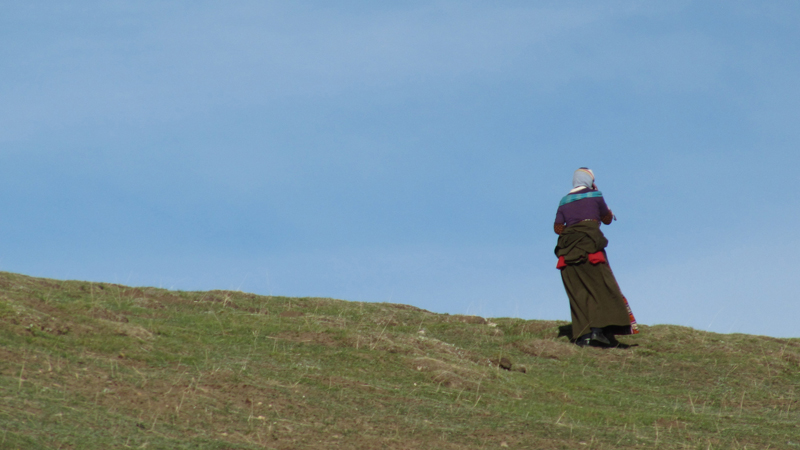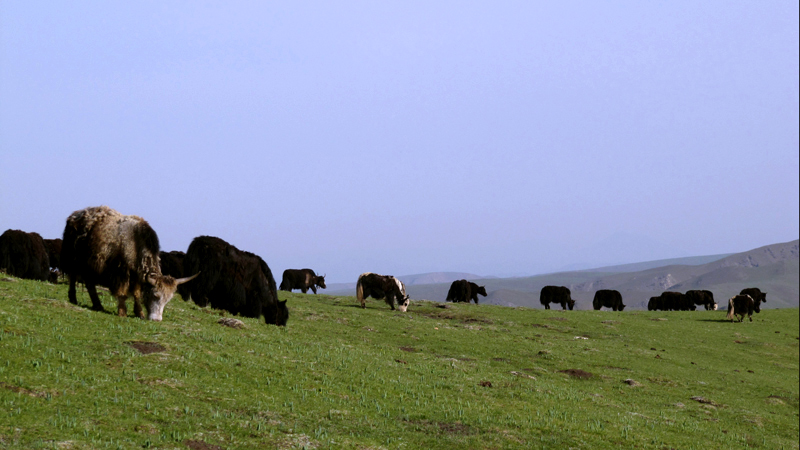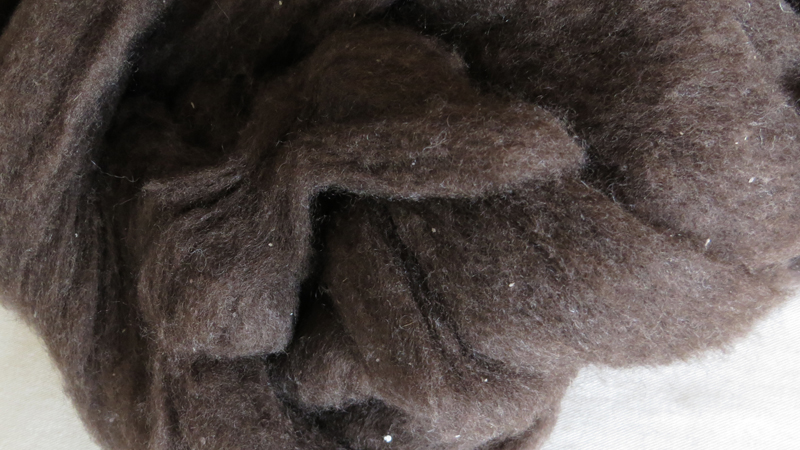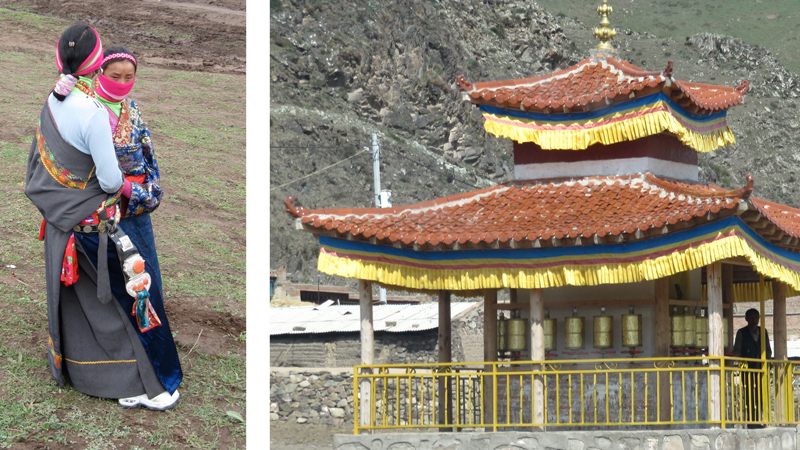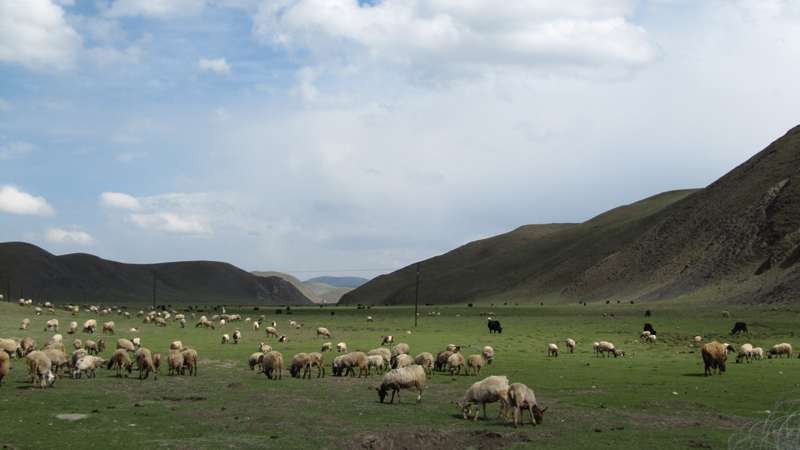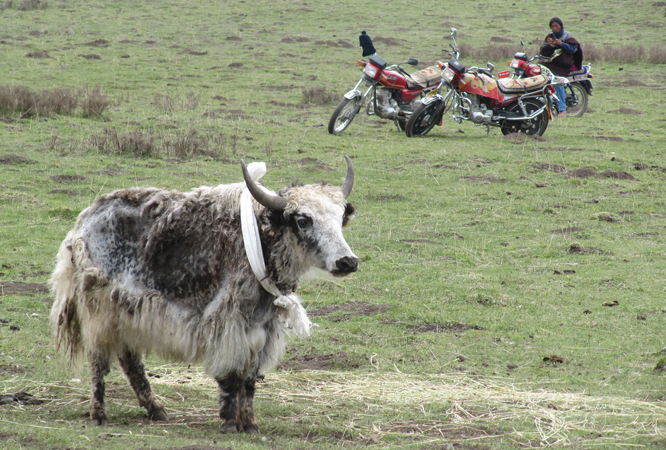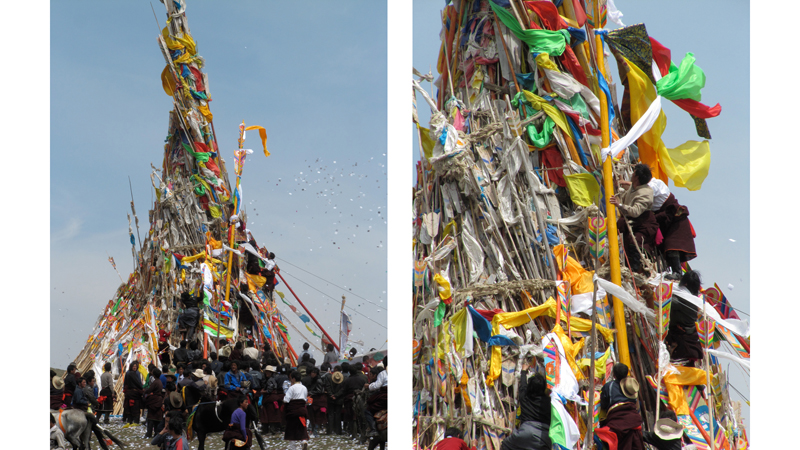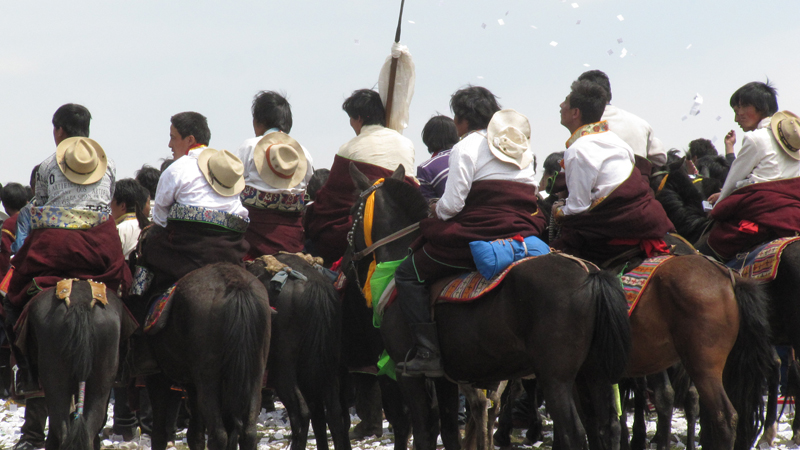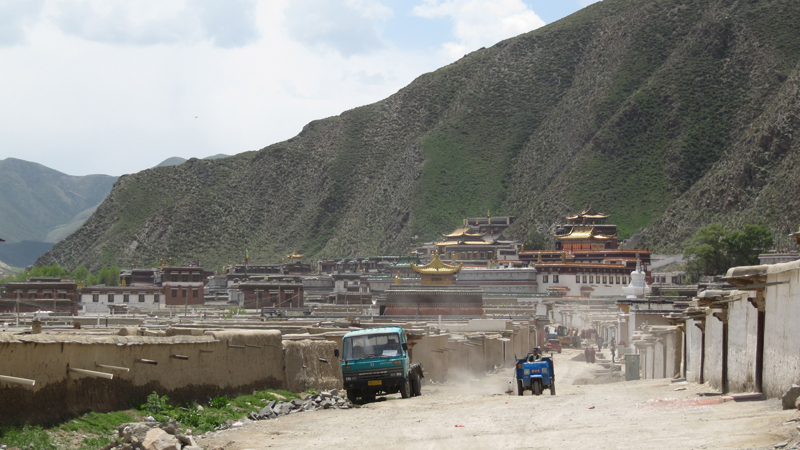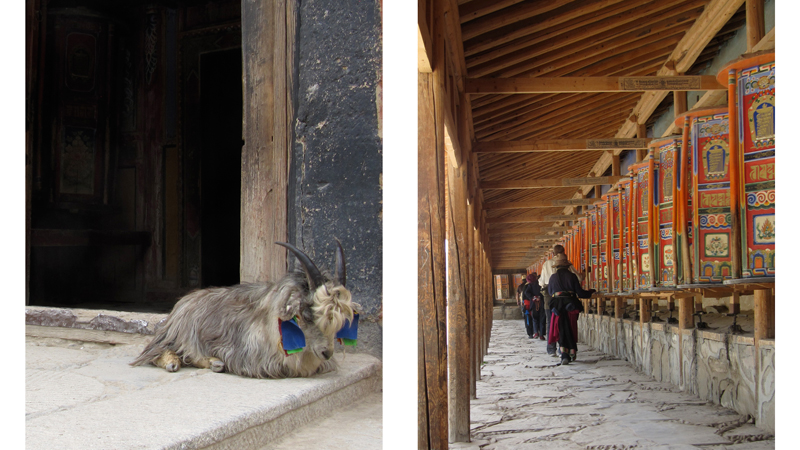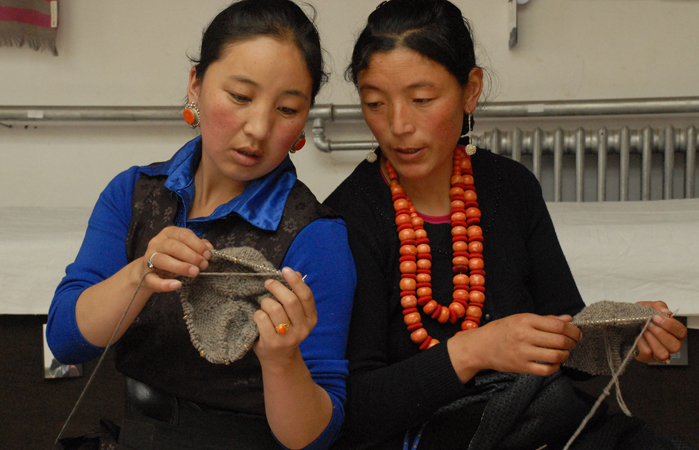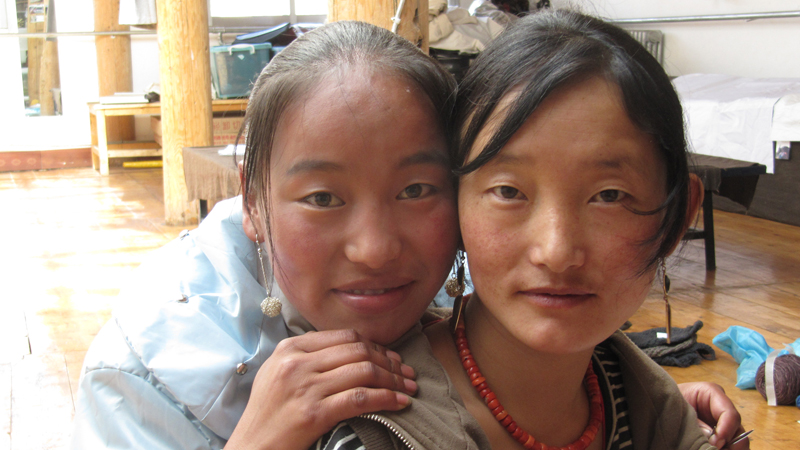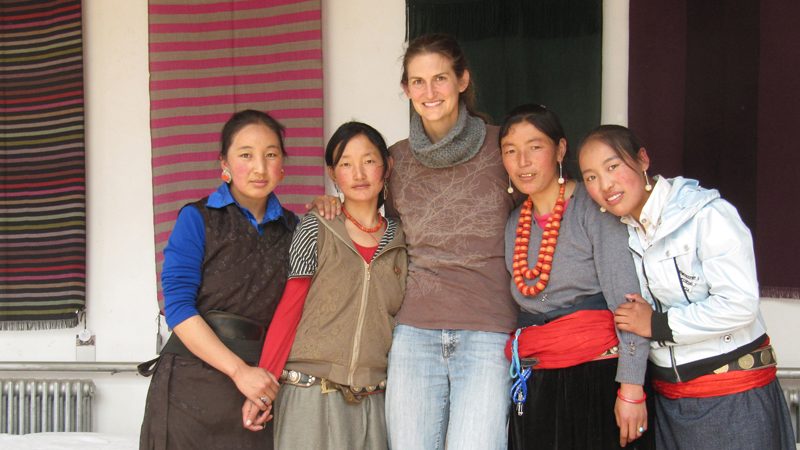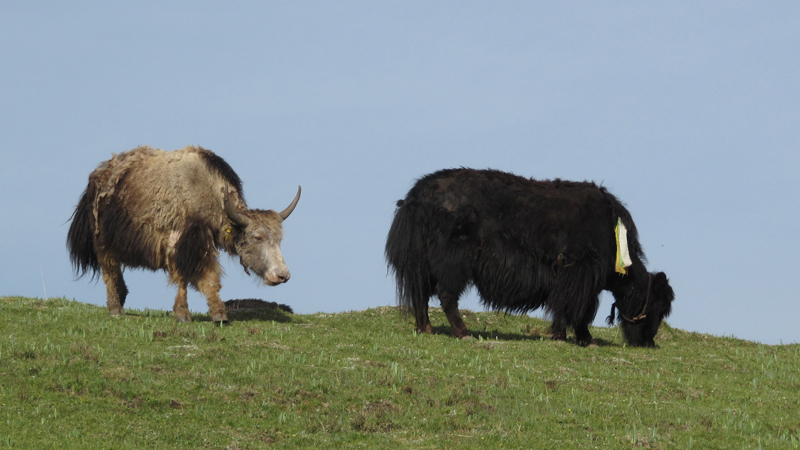Brilliant blue skies and vibrant fields of alpine herbs are home to the Amdo Tibetans of Zorge Ritoma, the local fibershed of Norlha, a textile workshop meshing modern and traditional fiber practice.
Zorge Ritoma on the Tibetan Plateau is home to Norlha, a textile workshop that specializes in creating gorgeous textiles from khullu, the soft insulating layer of Yak fiber. Akin to Fibershed ideals, Norlha has cultivated relationships with local nomadic herders, from whom they directly purchase Yak and sheep fiber. The workshop employs a group of approximately 100 persons from the village, offering well-paying, local employment for both women and men. Not only does Norlha have beautiful fiber in their products, but they also offer a path to continue sustainable traditional Tibetan livelihoods and culture.
Yaks are plentiful on the plateau as nomadic herding is the traditional lifestyle of Tibetans in the region. The yak is a dietary staple and a source of traditionally felted clothing. Norlha offers an additional market for yak husbandry.
A sample of Norlha’s yak fiber processed by Marcel Deshaies while developing custom machinery for the workshop. Yak khullu is an ultra soft and durable fiber similar to qiviut from Artic muskox. The best fiber is shed from 2-year-old yaks. Khullu’s staple length is short; it is just spinnable on a feather-weight drop spindle or with a deft hand on a floor wheel.
In the spring of 2011, Fibershed founder Rebecca Burgess introduced me to Kim and Dechen Yeshi, a mother/daughter team who founded and run Norlha respectively, via Marcel Deshaies. Dechen was looking for a knitter with some spinning skills to help expand their primarily woven activities to hand knits. I jumped at the chance to learn about such an intriguing group of people in what I consider to be one of the most mystical places on the planet.
Two women in modern traditional dress at a local horse race; a Buddhist temple near Zorge Ritoma.
So in June 2011, I boarded a plane for the interior of China with two suitcases full of knitting supplies. A little background: Zorge Ritoma is in the Gannan Tibetan Autonomous Prefecture in Gansu Province, China. It is a small village with maybe 50 houses — the first one was built in the 1960s — recall that this is a traditionally nomadic culture. The largest nearby town is Hezuo (~30 minutes by car on a rough mostly dirt road) and the largest city is Lanzhou (~ 4 hours away on major highways). This is the Amdo Tibetan region, one of the three major Tibetan cultures; Kham and U-Tsang being the other two. U-Tsang is also known as the Tibetan Autonomous Region whose capital is Lhasa. The area around Zorge Ritoma is an interesting mix of Han Chinese, Hui people who are descendants of Arabs and Persians that traveled the Silk Road, and Amdo Tibetans. Once in Zorge Ritoma, I undoubtably felt Tibetan culture.
Sheep grazing on the open plateau outside of Zorge Ritoma.
Two aspects of Norlha, Zorge Ritoma, and the Tibetan culture especially resonated with me. First is the seamless link between the people and the Earth. Unlike common American culture or even the urban Chinese cultures that I observed in Hezuo and Beijing, there is little infrastructure masking the interdependencies. Large portions of foodstuffs are sown/raised/collected within a family, pigs roam the roads, clothes are washed in the stream, the roads are dirt. This is a double-edged sword as such close connection to nature is a difficult existence on may levels. But there is something beautiful about knowing exactly how you are connected to natural cycles and also fulfilling in a way that I find lacking as I spend much time manipulating zeros and ones. A close connection to the land flows through Norlha’s processes despite their use of some modern equipment. Some fiber is hand-spun; dyes are chosen carefully to be as minimally disruptive to the environment as possible; the fabrics are hand-woven on floor looms; and all products are meticulously hand-finished. Norlha’s hand-spinning process is truly amazing, as the spinners use a custom-made (by Norlha craftsmen) spinning wheel that is similar to the charkha. Norlha is evidence that a successful and sustainable business model can be cultivated in close connection with the surrounding ecosystems.
Traditional and modern culture intermingles in many aspects of life. This yak was the first prize at a local horse race that the many in the village used motorcycles to attend.
The second aspect of my visit that touched me deeply is the community. Community as I know it in America, and I have wonderful family, friends, and colleagues, is not quite an accurate description. The people of Zorge Ritoma live as a community to survive. I don’t know the intricacies and complexities of the entire structure, but I observed relationships and situations that inspire. One of my favorite experiences during my 3.5 week trip was being invited (twice!) to help make fry bread. A group of ~4-5 families, some related and some neighbors, joined together in this process. In the morning, several women prepared the dough — an entire flour sack full, one of the 50 lb bags! Seven women and I knelt for several hours rolling, cutting, and shaping the dough while three men fried it in an oil-filled stone basin that had an oven below. The basin was built into a small room in a house, and it was the only one amongst the group. A pile approximately the size of 2 round bales of hay was produced during each session. The first night of work supplied the bread for one family’s contribution to their two son’s boarding school at a nearby monastery. The second night’s effort was distributed amongst the families and would last for many months. The community of people surrounding Norlha were extremely generous with each other and with me. Meals were shared, transportation was shared, laughter was shared. My involvement with Fibershed here is growing towards the community I witnessed in Zorge Ritoma and Norlha.
Some of the women that invited me to make fry bread. It is still quite chilly in early summer.
I was lucky to be in Zorge Ritoma during one of the largest festivals of the year — the English translation of the festival is unclear. The several day event included a large flag monument, each family and village contributing their colors; a series of horse races; singing concerts; and various sporting competitions. Dechen and her husband introduced me to the largest remaining Tibetan monastery, Labrang, in neighboring Xiahe. A beautiful, intellectual, and holy place. I tasted a wide variety of cuisine from elaborate Chinese restaurants, where you have a private dining room, to local noodle shops to homemade Tibetan fare. My favorite by far was the yak milk tea and boiled bread for breakfast at the workshop — delicious!!
The main flag monument during construction.
Men gather to observe the festival activities amongst a shower of prayer flags.
Labrang Monestary is nestled amongst the hillside in neighboring Xiahe.
A sacred goat marked by his ear flags; prayer wheels line the exterior of Labrang and see active use.
Despite the huge language barriers, I was able to communicate quite well with members of the Norlha knitting team: Kharmo, Ghati, Kyikoo, and Wan ma Tso. This was especially true once the team was able to understand my ill-pronounced tonscha (knit) and shemsh (purl). Much thanks to several of the Norlha management (Dhunko and Seru, along with Dechen who offered more advanced translations). Kyikoo and Wan ma Tso were relatively new knitters, but as the younger members of the team, they were anxious and quick to learn. Kharmo and Ghati were experienced knitters — able to make items without pattern and with complicated technique. Their ability to knit pattern-free was at the crux of setting up the knitting program. Items needed to be somewhat standardized in order to be marketable. So we focused our efforts on matching gauges by developing a swatch library augmented by blocking techniques. We prioritized pattern writing and reading. It was a whirlwind, intense, and extremely satisfying teaching and learning experience. And I’m happy to report that Norlha just released its first knitting collection (pdf) this year!
Ghati and Kharmo discussing a step during pattern reading. Photo: Dechen Yeshi.
Wan Ma Tso and Kyikoo.
The Norlha knitting team and me, framed by a sample of Norlha’s woven scarves. Photo: Dhunko.
Norlha symbolizes what is possible in a complicated landscape of tradition and modernization: maintaining local connections to the land and integrating sustainable modern practices to produce truly fantastic textiles. It is my hope that Fibershed and Norlha can continue to learn from each other as sister fibersheds increasing the sustainability of human culture.

